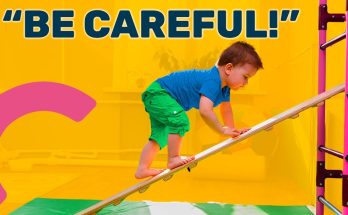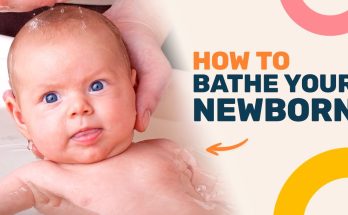Bathing your newborn for the first time can feel like a big milestone for new parents. It’s an exciting moment but can also be filled with questions and concerns, especially if you’re unsure about the best way to handle your baby in the water. Understanding the process, having the right supplies, and knowing when and how to give your baby their first bath will help ensure the experience is safe, comfortable, and enjoyable for both you and your little one.
Timing the First Bath
Newborns are typically not bathed right away after birth. Instead, their first bath is usually given after their umbilical cord stump has fallen off and the area has healed, which typically happens within the first few weeks. Until then, your baby’s skin doesn’t require frequent washing, and keeping the cord stump clean and dry is important. Most doctors recommend waiting until at least 7 to 10 days after birth to give your baby their first full bath.
Before this time, your baby’s hygiene can be maintained with gentle sponge baths using warm water and soft washcloths. If your baby’s skin is dry or flaky, a sponge bath will help clean them without irritating their delicate skin.
Preparing for the First Bath
Before you begin your baby’s first bath, you need to gather everything you’ll need. Preparation is key to ensuring you don’t have to leave your baby unattended at any point. Here’s what you will need:
- A baby bath tub: For safety and convenience, use a baby bath tub that is specifically designed for infants. It provides the proper support for your baby while keeping them comfortable during the bath.
- Mild baby soap and shampoo: Choose a gentle, fragrance-free soap and shampoo that is suitable for newborns, as their skin is sensitive.
- Soft washcloths: You’ll need one or two soft washcloths to wash your baby’s body and face.
- Towel: Have a soft, hooded towel ready to dry your baby immediately after the bath.
- Lukewarm water: Ensure that the water is lukewarm (around 100°F or 37°C). Test it with your wrist or elbow to make sure it’s not too hot or too cold.
Setting Up the Bath Area
Pick a warm, quiet space for your baby’s first bath. Make sure the room is free from drafts and that the temperature is comfortable. You don’t want your newborn to get chilled while bathing, so maintaining warmth is essential. You can set up the baby bath tub in a sink, a counter, or on the floor—whichever feels easiest and safest for you.
Ensure all supplies are within easy reach before you begin the bath. Having everything ready and organized means you can focus on your baby’s safety and comfort during the bath.
Bathing Your Newborn
Here’s a simple step-by-step guide on how to give your newborn their first bath:
- Undress your baby: Start by carefully undressing your baby, leaving their diaper on for now. You can remove the diaper later, after the first few steps of the bath are completed.
- Check the water temperature: Before placing your baby in the bath, test the water temperature with your wrist or elbow. It should feel comfortably warm, not hot. Always be sure the water is at a safe temperature, as babies have very sensitive skin.
- Support your baby: Gently hold your baby with one arm, supporting their head and neck at all times. With your other hand, gently place your baby into the bath tub, making sure their body is fully supported. If using a baby bath tub, keep a firm grip on your baby to prevent slipping.
- Wet and wash your baby: Use a soft washcloth to gently wet your baby’s body with lukewarm water. Start with their head and face, using the washcloth to gently wipe their face, avoiding getting water in their eyes or ears. You can also use a cotton ball or a soft cloth to wipe their eyes and remove any crusts or debris.
- Wash the body: Once the baby’s face is clean, move on to the body. Apply a small amount of mild baby soap to the washcloth and gently wash their arms, torso, and legs. Be sure to wash their neck, underarms, and diaper area as well, as these spots tend to get dirty quickly.
- Rinse and dry your baby: After you’ve finished washing your baby, it’s time to rinse off the soap. You can either use the washcloth or your hand to gently pour warm water over your baby’s body. After rinsing, immediately lift your baby from the tub and wrap them in a soft towel. A hooded towel is ideal for drying their head and keeping them warm.
Post-Bath Care
After the bath, take a few moments to gently pat your baby dry with the towel. Be especially gentle around the skin folds, such as in the neck, under the arms, and in the diaper area. These areas can retain moisture, so drying them thoroughly will help prevent rashes.
If your baby’s skin is dry, you can apply a gentle baby moisturizer to keep their skin soft and hydrated. This step is optional, but it can be beneficial if your baby’s skin appears flaky or dry.
Safety Tips for Bathing Your Newborn
- Never leave your baby unattended in the water: Always keep one hand on your baby while they’re in the bath to prevent slipping or drowning. Never leave your baby alone, even for a moment, during bath time.
- Keep the water shallow: Make sure the water level in the bath tub is shallow—about 2-3 inches of water is plenty for a newborn. Babies don’t need much water for a bath.
- Avoid using harsh soaps or products: Newborns have delicate skin that is sensitive to strong fragrances and chemicals. Always choose baby-safe products that are free from artificial scents, parabens, or harsh detergents.
Conclusion
Bath time can be an enjoyable and bonding experience for both you and your newborn. By following the right steps, you can ensure that your baby’s first bath is a safe, comfortable, and soothing experience. Remember to keep the water temperature just right, provide gentle support for your baby’s body, and focus on creating a calm and warm atmosphere. With a little practice, you’ll soon feel more confident in handling bath time, making it a special moment for both you and your baby as you navigate the early stages of parenthood.



